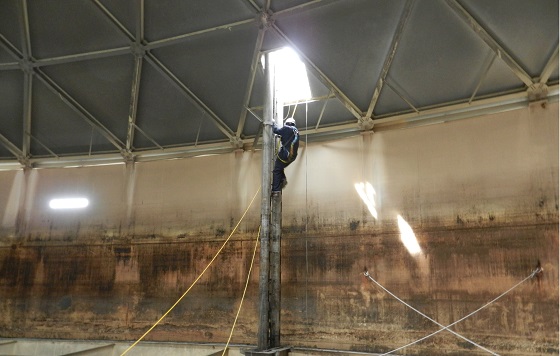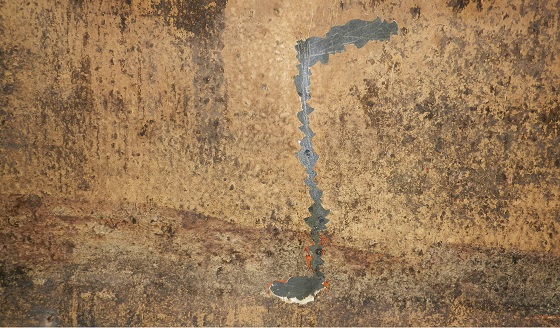What’s the difference between condensation on a cold can of “pop” on a warm summer day and osmotic blistering of a paint system due to the cold wall effect?
It’s a trick question. From a technical perspective, there’s no difference at all. From a practical perspective, one is a sugary, bubbly pleasure, and the other is a massive catastrophic paint system failure in the offing.
The cold wall effect is one of those concepts in the paint and coating world that resides almost exclusively in the realm of aboveground storage tanks (ASTs). But as corrosion professionals, it should be a phenomenon that we are familiar with and understand. And, most importantly, know how to defeat.
What Is It?
I was first introduced to the concept about 30 years ago when evaluating a variety of thick-film (20−60 mils, or 508.0−1,524.0 microns) coating systems for the interior of a small outdoor AST, which had a 10-foot
(3.1 m) diameter and was 20-feet
(6.1 m)
tall. It contained wastewater and trace amounts of water treatment liquids. One of the vendors submitted a product for my review for the benefit of a client, and I noticed in the product data sheet that any AST needed to be insulated — or there would be no warranty.
My ignorance trumped my curiosity, and I called the material supplier to ask what kind of nonsense this was. Why in the world does it matter if the tank is insulated or not? How does the coating system on the inside of the tank know if the outside of the tank is insulated or not?
Back to our thirst-quenching cold can of pop: When the cold can comes into contact with warm, humid air, the moisture vapor in the air condenses onto the cold can. This is one of the reasons we calculate dew point during coating applications: to ensure that our substrate is sufficiently dry for coating.
Speaking of dew point for a moment, many decades ago, I was lining the interior of an underground gasoline storage tank on a very humid Chicago day. I was blasting the interior, and we had air circulating through the tank. Other than immediately around the manhole, which was warmer due to the lack of earth above it, I could not keep the tank blasted. We were shooting for a white metal blast, and the instant I would blast, condensation would form. There was nothing that we could do other than pack it in for the day.
This is the type of condensation associated with dew point that we’re all familiar with.
The cold wall effect is similar but in a slightly inside-out way.
Let’s say you coat the interior of a 10 feet by 20 feet (3.1 x 6.1 m) tall water tank. And let’s say the water inside the tank stays between 60 and 90 °F (15.6−32.2 °C), and that the AST is in the Chicago area. Unless you’ve applied a very thick and durable coating with a very, very low permeability rate, every winter will bring you closer and closer to disaster in the form of osmotic blistering (which, by the way, will likely be worse in the ullage, or air gap, area than in the AST’s liquid area).
Here’s why.
The warm water is our equivalent of the warm air surrounding our can of pop. The cold wall refers to the external surfaces of the tank, which are exposed to the vagaries of a Chicago winter — where temperatures routinely run below freezing for days on end. In fact, stretches below zero are not uncommon.
The water molecules inside the tank want to get to the cold wall on the outside. (In the ullage area, the water vapor molecules are smaller and, therefore, more insidious, too.) There is a driving force that is actually drawing the warm water and water molecules to the cold exterior wall of the tank, trying to reach a temperature equilibrium.
Over time, depending on the temperature differential and permeability of the coating, you will develop osmotic blistering. The water vapor molecules will hit the cold wall and condense, forcing the coating to blister. The solution is to insulate the cold side of the tank to stop that driving force of equilibrium.
Real World Experiences
In at least one case I was involved in, the water vapor had penetrated underneath the coating without causing any blisters at all.

On another case, we inspected the floating roof of a 250-foot (76.2 m) diameter wastewater treatment tank outside of Chicago. There was a vast array of issues with the tank, ranging from galvanic corrosion to inter-coat delamination, but we were called in to evaluate the condition of the coating above the floating roof. Not surprisingly, there were small blisters under which you would expect to find some type of liquid, aka, in lab parlance, “blister liquid.”
 We were doing an abrasive blasting proof of concept, and we could see that the water was blasted to the right but then dripped down after blasting stopped.
We were doing an abrasive blasting proof of concept, and we could see that the water was blasted to the right but then dripped down after blasting stopped.
However, what was more perplexing was that when I started to scrape a random area of coating that looked well-adhered and blister-free, water was found everywhere beneath the coating.
On closer examination, when looked at sideways, the coating system did show very “flat” blisters. This indicated that water had found its way beneath the coating, but the coating was so ridged and well adhered that the driving force of the water beneath the coating was not strong enough to raise blisters. In this case, the client was looking to get another two years out of the coating before taking it out of service for a complete rehab. That meant that at 2 a.m., a crew of sandblasters and I figured out a way to identify areas that were problematic, blast only those areas, and touch up the system as required. The fix worked like a charm and was still performing well five years later, when they found time to complete a turnaround.

Paper Play
If you haven’t run into the cold wall effect before, it may sound kind of hokey — at least it did to me, at first. If you’re still not a believer, try this.
Take your cold can of pop and bring it outside on a hot, humid day. Start by wrapping the can tightly with paper. You will find that the water will condense, not on the paper but behind it. Keep adding sheet after sheet of paper, and you will see the process slow (every time you double the thickness of a material, its permeation rate drops by half).
The paper does not have time to get cold. The water vapor is being drawn through the paper, hitting the cold wall of the can — and condensing behind the paper.
In our tank setting, the coating system is our paper. The insulation on the exterior serves one and only one purpose: to shield the tank wall and make it the same temperature (whatever that may be) as the liquid inside — thus reducing, or removing, the temperature gradient. And there’s the answer to our pop question!
About the Author
 Warren Brand heads Chicago Corrosion Group, a leading vendor-neutral consultancy. Brand’s career has covered more than four decades. He has owned an industrial tank lining and coating firm and has written dozens of blogs and technical articles in a variety of publications. He has managed thousands of coating installation projects and developed specs for thousands of paint and coating applications. Brand, who is a certified NACE Level 3 and The Society for Protective Coatings (SSPC) protective coating specialist (PCS), has earned an MBA and is a martial arts aficionado. For more information, contact: Warren Brand, warren@chicagocorrosiongroup.com
Warren Brand heads Chicago Corrosion Group, a leading vendor-neutral consultancy. Brand’s career has covered more than four decades. He has owned an industrial tank lining and coating firm and has written dozens of blogs and technical articles in a variety of publications. He has managed thousands of coating installation projects and developed specs for thousands of paint and coating applications. Brand, who is a certified NACE Level 3 and The Society for Protective Coatings (SSPC) protective coating specialist (PCS), has earned an MBA and is a martial arts aficionado. For more information, contact: Warren Brand, warren@chicagocorrosiongroup.com